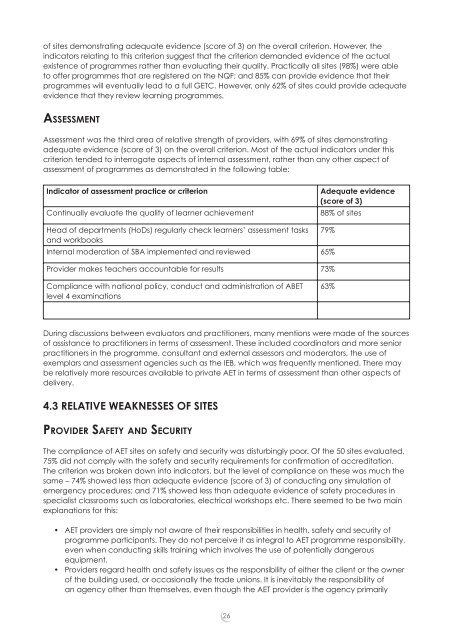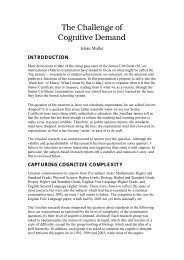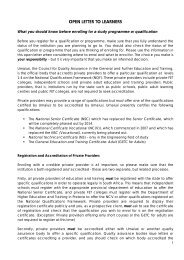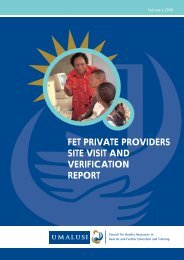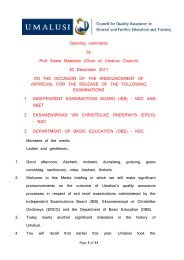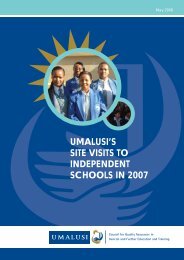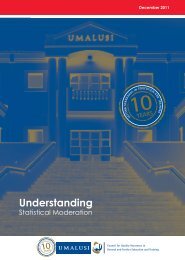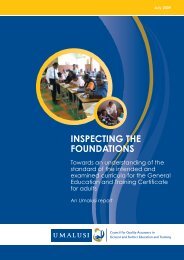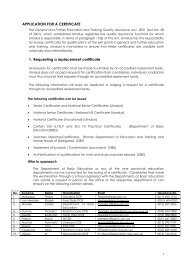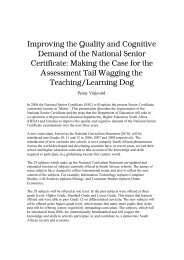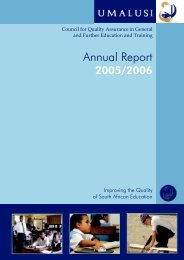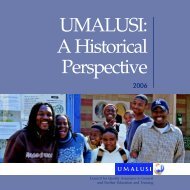Umalusi AET Report
Umalusi AET Report
Umalusi AET Report
- No tags were found...
You also want an ePaper? Increase the reach of your titles
YUMPU automatically turns print PDFs into web optimized ePapers that Google loves.
of sites demonstrating adequate evidence (score of 3) on the overall criterion. However, theindicators relating to this criterion suggest that the criterion demanded evidence of the actualexistence of programmes rather than evaluating their quality. Practically all sites (98%) were ableto offer programmes that are registered on the NQF; and 85% can provide evidence that theirprogrammes will eventually lead to a full GETC. However, only 62% of sites could provide adequateevidence that they review learning programmes.ASSESSMENTAssessment was the third area of relative strength of providers, with 69% of sites demonstratingadequate evidence (score of 3) on the overall criterion. Most of the actual indicators under thiscriterion tended to interrogate aspects of internal assessment, rather than any other aspect ofassessment of programmes as demonstrated in the following table:Indicator of assessment practice or criterionContinually evaluate the quality of learner achievementAdequate evidence(score of 3)88% of sitesHead of departments (HoDs) regularly check learners’ assessment tasks 79%and workbooksInternal moderation of SBA implemented and reviewed 65%Provider makes teachers accountable for results 73%Compliance with national policy, conduct and administration of ABETlevel 4 examinations63%During discussions between evaluators and practitioners, many mentions were made of the sourcesof assistance to practitioners in terms of assessment. These included coordinators and more seniorpractitioners in the programme, consultant and external assessors and moderators, the use ofexemplars and assessment agencies such as the IEB, which was frequently mentioned. There maybe relatively more resources available to private <strong>AET</strong> in terms of assessment than other aspects ofdelivery.4.3 RELATIVE WEAKNESSES OF SITESPROVIDER SAFETY AND SECURITYThe compliance of <strong>AET</strong> sites on safety and security was disturbingly poor. Of the 50 sites evaluated,75% did not comply with the safety and security requirements for confi rmation of accreditation.The criterion was broken down into indicators, but the level of compliance on these was much thesame – 74% showed less than adequate evidence (score of 3) of conducting any simulation ofemergency procedures; and 71% showed less than adequate evidence of safety procedures inspecialist classrooms such as laboratories, electrical workshops etc. There seemed to be two mainexplanations for this:• <strong>AET</strong> providers are simply not aware of their responsibilities in health, safety and security ofprogramme participants. They do not perceive it as integral to <strong>AET</strong> programme responsibility,even when conducting skills training which involves the use of potentially dangerousequipment.• Providers regard health and safety issues as the responsibility of either the client or the ownerof the building used, or occasionally the trade unions. It is inevitably the responsibility ofan agency other than themselves, even though the <strong>AET</strong> provider is the agency primarily26


